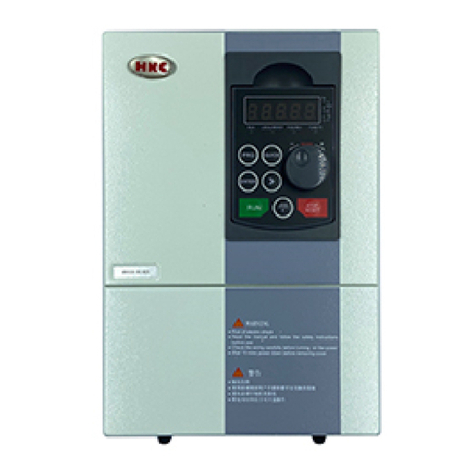
HV350 Mini Frequency Inverter User Manual
Contents
Chapter 1 Introduction to HV350 Series Inverter ...............................................................................3
1.1 Product Model Description..................................................................................................................3
1.2 Safe Precaution..................................................................................................................................4
1.3 Product Series....................................................................................................................................7
1.4 Product Specifications........................................................................................................................8
1.5 Product Component Name...............................................................................................................10
1.6 Product Outline, Mounting Dimension, and Weight ...........................................................................10
1.7 Operation Panel Outline and Mounting Dimension............................................................................11
1.8 Braking Resistor Lectotype...............................................................................................................11
Chapter 2 Inverter Installation...........................................................................................................12
2.1 Environment for Product Installation.................................................................................................12
2.2 Mounting Direction and Space..........................................................................................................12
2.3 Removal and Mounting of Operation Panel and Cover......................................................................13
Chapter 3 Wiring of Inverter..............................................................................................................16
3.1 Connection of the Product and Peripheral Devices ...........................................................................16
3.2 Description of Peripheral Devices for Main Circuit.............................................................................17
3.3 Lectotype of mMain Circuit Peripheral Devices.................................................................................18
3.4 Product Terminal Configuration.........................................................................................................18
3.5 Functions of Main Circuit Terminal....................................................................................................18
3.6 Attention for Main Circuit Wiring........................................................................................................20
3.7 Terminal Wiring ................................................................................................................................20
3.8 Functions of Control Circuit Terminals...............................................................................................21
3.9 Lectotype of Control Circuit Peripheral Devices ................................................................................23
Chapter 4 Using Instructions of Operation Panel ............................................................................24
4.1 Introduction to Operation Panel........................................................................................................24
4.2 Descriptions of Indicators .................................................................................................................25
4.3 Description of Keys on Operation Panel............................................................................................25
4.4 Keypad Operating Status..................................................................................................................25
4.5 Panel Operation Method...................................................................................................................25
4.6 Parameter Display............................................................................................................................28
4.7 Motor auto-tuning procedure ............................................................................................................29
4.8 Running for the First Time................................................................................................................29
Chapter 5 List of Parameters ............................................................................................................30
5.1 Function Parameter Table.................................................................................................................30
Chapter6 Detail Function Introduction................................................................................................49
P0 Basic function parameters.................................................................................................................49
P1 Auxiliary function parameters 1 .........................................................................................................54
P2 Auxiliary function parameters 2 .........................................................................................................58





























